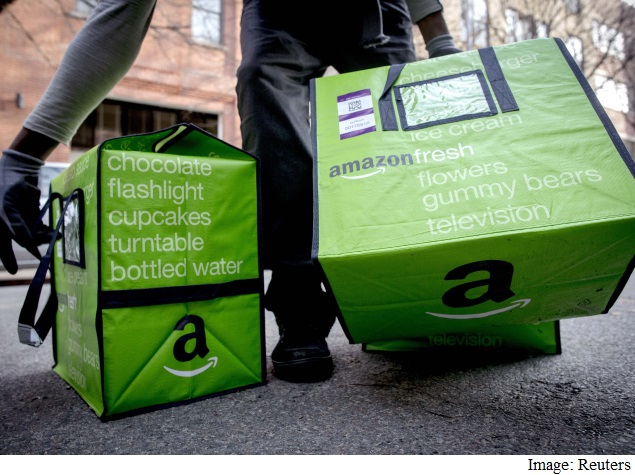- Home
- Internet
- Internet News
- To Gain the Upper Hand, Amazon Disrupts Itself
To Gain the Upper Hand, Amazon Disrupts Itself

Analysts were expecting the usual gangbusters third quarter. But it was about $250 million (roughly Rs. 1,549 crores) short of forecasts.
Here is one way to look at the disappointing results: Amazon, for all its heft, is starting to lose momentum. It was rejected by some customers who were put off by its acrimonious dispute with the publisher Hachette over ebooks, while others found its prices less compelling than they once were.
(Also see: Hachette, Amazon End Nasty Feud With Deal on Book Sales)
But few things about the retailer are ever clear-cut, so here is another interpretation: Amazon is intentionally cannibalizing some major product lines - offering free or nearly free music, video and ebooks - to draw tens of millions of people into its ecosystem.
Far from being weak, Amazon in this view is so strong that it is disrupting not only other retailers but itself, knowingly and eagerly, as it seeks to leverage its powerful e-commerce operation to become a retail and entertainment colossus. It wants to sell devices, entertainment and services as well as basics like milk and toilet paper.
"Everything you buy, starting with your weekly groceries, will be flowing through one pipe called Amazon," said Scott Galloway, a professor of marketing at New York University's Stern School of Business. "They'll have your credit card purchase history, be able to do data-mining on your needs, offer massive selection with a reputation for low prices."
Building that pipe requires nimble execution and vast investments. Amazon said Monday that it would be raising a significant but unstated amount of money through a debt offering, which caused Moody's Investors Services to cut its outlook to "negative" from "stable." Amazon secured a $2 billion (roughly Rs. 12,400 crores) line of credit in September.
In its 20th year, Amazon's losses are increasing. Critics say the company is too ambitious. Admirers believe it will dominate in a way no company ever has.
"I don't think they want to own a piece of retail," Galloway said. "They want to own all of it."
But the risks are great. Amazon needs to be aggressive, but that behavior can backfire. Some analysts said Amazon took in less revenue than expected in the third quarter at least in part because some customers were turned off by its confrontation with Hachette. If one category - North American media sales, which means books, DVDs and CDs - had performed the way it usually did, Amazon would have made that $250 million.
Michelle Hamilton, a recently retired Southern California marketing executive, is one of those disenchanted customers.
Her family of four has ordered 923 times from Amazon since 2001, at a pace that was rapidly accelerating until recently. Last year, they placed 167 orders - nearly every other day. They bought their books at independent stores, but otherwise used Amazon for items like music and a hard-to-find dishwasher salt, Somat.
Amazon's dispute with Hachette surprised and disappointed Hamilton, 56. She wrote a letter of complaint to Amazon's chief executive, Jeff Bezos, but never heard back, which disappointed her more.
"Why wouldn't he be interested in constructive criticism from customers who would like to love Amazon again?" she asked.
An Amazon spokeswoman declined to comment about why Bezos declined to respond to those who wrote to him about Hachette.
Amazon rapidly went from Hamilton's first stop to the last. She calculated that her family's spending last summer with the retailer fell 61 percent from last year.
Before the third quarter, North American media sales were increasing an average of 15 percent year over year. The latest increase was less than 5 percent, which made it the slowest quarterly growth for the category in five years.
When Amazon reported its latest financials, it gave two explanations for the slowdown in media growth: Customers were renting textbooks instead of buying them, and there were difficult comparisons with the third quarter of 2013, which featured heavy discounting.
If Amazon means that prices are now higher than they were, that is something Brian A. Rosenwald knows all about.
A doctoral candidate in U.S. history at the University of Virginia who needs to stretch his entertainment dollars, Rosenwald likes to buy hardcover mysteries so he can pass them on to his father. He has noticed his Amazon discount shrinking. Two years ago he paid $14.01 for the new volume by John Sandford in his Prey series. This year's volume was released in the spring with a publisher's list price of $1 more than the earlier volume. It never got lower than $17.32.
So Rosenwald is cutting back. Last year, he bought 17 printed novels from Amazon. So far this year he has bought three.
"I'm shifting to buying more very lower-dollar digital items instead of more expensive physical items," he said. "Even then, I'm almost entirely buying during sales."
If customers think of Amazon less in terms of individual products and more as a bundle of goods and services, then price shifts are less relevant. And the company is constantly working to augment that bundle. For several years, it has offered members of its Prime shipping service free video streaming. It has been spending heavily to add original programming. During the summer, Amazon introduced a Prime music service and, for a monthly fee, a book subscription service.
While Amazon does not give numbers of Prime subscribers, most analysts think those numbers have been increasing rapidly from a base of 20 million. The Prime subscribers, who pay $99 a year for two-day shipping and all of the media, are the most enthusiastic Amazon customers. Set against that opportunity, what is a few missing books and tape sales?
"In essence it appears they're mortgaging one smaller business," media sales, "to drive the much bigger, longer-term business opportunity of overall retail leadership," said Peter Hildick-Smith of the Codex Group, a book-industry research firm.
That, he added, has risks for content creators, which might be one reason the traditional publishing industry was on edge during the standoff with Hachette.
"If books, video and music continue to be relegated to a 'free' commodity for all Prime customers to enjoy, does this then ultimately devalue each of these content markets, in the process marginalizing their producers' business models?" Hildick-Smith asked.
Even as Amazon moves aggressively to reshape media consumption, however, it is trying many other merchandising formats. For instance, it just introduced the Echo, an oddball interactive cylinder for the home that, among other features, allows hands-free shopping.
Then there is the frenzy over physical stores, which are this year's equivalent of delivery by drone - a development that excites the imagination but is unlikely to come to pass any time soon.
When The Wall Street Journal reported in early October that Amazon was opening "the first brick-and-mortar outlet in its 20-year history" across from the Empire State Building "in time for the holiday-shopping season," the news unleashed a torrent of commentary despite a lack of confirmation from Amazon.
Galloway, who also runs an e-commerce consulting firm, L2, argues that the future belongs to multichannel merchants - those who let customers order online and pick up in a physical location, or who ship online and allow for returns in a physical location, or who allow browsing in a store but ship to a home.
"Stores may have found the vulnerable soft-tissue of Amazon: its lack of stores," Galloway said. "This is the revenge of the brick."
He believes that within the next 12 months Amazon will be opening hundreds of "dark" stores, which are places where people can pick up things, or make a "transformative acquisition" along the lines of Best Buy or Radio Shack.
But people are not going to be getting their stuff from an Amazon store in Manhattan this holiday season. A spokeswoman said in a statement that the 470,000-square-foot building was "primarily" corporate office space, and that the ground floor retail shops would be subleased.
As so often regarding Amazon, speculation outran reality.
© 2014 New York Times News Service
Catch the latest from the Consumer Electronics Show on Gadgets 360, at our CES 2026 hub.
Related Stories
- Samsung Galaxy Unpacked 2025
- ChatGPT
- Redmi Note 14 Pro+
- iPhone 16
- Apple Vision Pro
- Oneplus 12
- OnePlus Nord CE 3 Lite 5G
- iPhone 13
- Xiaomi 14 Pro
- Oppo Find N3
- Tecno Spark Go (2023)
- Realme V30
- Best Phones Under 25000
- Samsung Galaxy S24 Series
- Cryptocurrency
- iQoo 12
- Samsung Galaxy S24 Ultra
- Giottus
- Samsung Galaxy Z Flip 5
- Apple 'Scary Fast'
- Housefull 5
- GoPro Hero 12 Black Review
- Invincible Season 2
- JioGlass
- HD Ready TV
- Laptop Under 50000
- Smartwatch Under 10000
- Latest Mobile Phones
- Compare Phones
- OnePlus Turbo 6V
- OnePlus Turbo 6
- Itel Zeno 20 Max
- OPPO Reno 15 Pro Mini 5G
- Poco M8 Pro 5G
- Motorola Signature
- Vivo Y50e 5G
- Vivo Y50s 5G
- Lenovo Yoga Slim 7x (2025)
- Lenovo Yoga Slim 7a
- Realme Pad 3
- OPPO Pad Air 5
- Xiaomi Watch 5
- Huawei Watch 10th Anniversary Edition
- Acerpure Nitro Z Series 100-inch QLED TV
- Samsung 43 Inch LED Ultra HD (4K) Smart TV (UA43UE81AFULXL)
- Asus ROG Ally
- Nintendo Switch Lite
- Haier 1.6 Ton 5 Star Inverter Split AC (HSU19G-MZAID5BN-INV)
- Haier 1.6 Ton 5 Star Inverter Split AC (HSU19G-MZAIM5BN-INV)

















